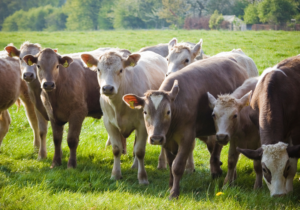
The importance of management and attention to detail with beef systems can have significant benefits to business profitability. As with any business there are some key factors that contribute to success more so than others. Feeding according to home grown resources, animal type and breed, and preparing a carcass to meet the requirements for the end market are well known points within the beef sector. However, attention to age of first calving, early life calf growth, genomics and specific nutritional variations for different growth stages are key parameters that can be overlooked.
Attention to detail pays throughout the beef production cycle as seen on farms all over the country. From analysing grassland and forage for a basic nutrient analysis, but also conducting a more detailed mineral analysis’, to cow colostrum quality and a calves immediately post calved colostrum intake. For certain beef systems, forage will make up the significant proportion of the diet, knowing the detail will enable accurate balancing to meet nutritional needs but also ensure this is done in the most financially feasible way. This is not only from a choice of supplement perspective but also how much to feed. A quality forage analyses may enable lower supplementation rates but may also require more fibre to ensure rumen health remains high. Whereas a dry, high fibre forage may need more fermentable carbohydrates such as molasses or very fermentable starch to drive rumen fermentation and therefore growth or milk yield. Forage analyses is not just about energy and protein, pay attention to fibre to gage rumen health and intake potential, and parameters such as Acid Load to determine how much you can push cattle on.
Analysing forage will enable diet ‘tweaks’ in particular growth stages to maximise growth yield. For example, a protein deficiency in pre-puberty animals could result in lower structural growth and therefore a lower withers height in adult cattle. It is not uncommon to harvest silages at 12% protein or less, meaning a concentrate supplement would need to be 20% protein to accurately balance. Where-as a 15% protein silage may only require a 16% protein concentrate to balance, that could be as much as £10/tonne difference in price.
A forage mineral analyses is also an easy way to ensure that any potential mineral deficiencies or excesses are solved beforehand, as they can become costly. If balanced correctly, a bespoke mineral may even save money, as there is just as much chance of over feeding minerals as under feeding them. It may also point out any specific mineral imbalances that are naturally occurring in the forage. For example, high molybdenum, sulphur and/or iron will make copper less available and leave cattle deficient. Simply lifting copper in the mineral, however, is not always the answer. Using alternative sources of copper will increase bioavailability whilst ensuring cattle are not overfed. Selenium is another trace mineral that, depending on region can often be found as deficient. Both copper and selenium play important roles in immunity and fertility and supplementing accurate levels and sources can yield long term results.
For finishing cattle of course, forage plays a far less significant part and focus should be on starch levels within the diet. At this point farmers must look at the starch sources used and pay close attention to rumen health. A finishing diet based on barley, wheat and confectionary products will deliver a 50%+ starch diet but high levels of quickly fermented starch creating a high acid loading. But when that diet is based on treated wheat (to buffer the rumen or increase by-pass starch), maize and some barley, the diet is still 50%+ starch but 30% less fermentable in the rumen and increasing by-pass starch by nearly 50%. This will put significantly less stress on the rumen, reducing acidosis risk and improving performance.
Colostrum quality is also something that is often overlooked, ensuring calves have the best start to life can yield dividends in later life efficiencies. Although not as straightforward to do compared to their dairy counterpart, an effective way to measure and monitor colostrum is by using a refractometer on a colostrum sample to ensure qualities meet expectations, and if they don’t either use a quality colostrum replacer or make the relevant changes to your dry cow system to improve future qualities.
Attention to detail in geonomics has been paying off for many producers, recording top class and functional animals in shorter periods of time. Understanding your target market whether that is breeding stock or selling deadweight, the use of estimated breeding values (EBVs) are proving their worth to beef businesses. Three key traits farmers should be paying attention to are calving ease, growth and carcass traits and intramuscular fat (IMF), helping to make informed management decision and therefore profitability and efficiency.
For more information or advice on maximising your beef enterprise, speak to the NWF Technical team on 0800 756 2787, or speak to your local NWF Sales Specialist or visit our beef webpage HERE.

